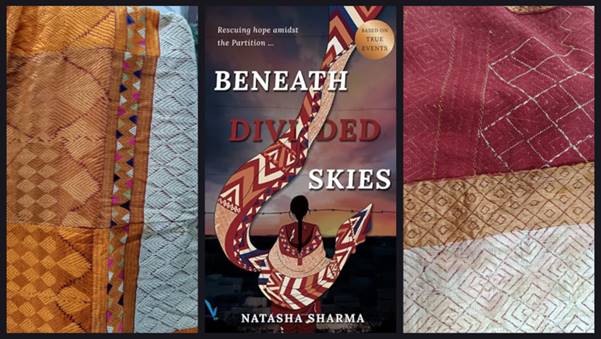
Natasha Sharma’s novel ‘Beneath Divided Skies’ about a woman’s plight during the 1947 Partition and in coming decades highlights the gendered suffering that conflict and war unleash on women
By Shalini Mullick
Gurgaon, India
In times of war, strife, and struggle, does gender play a role? Is there a gender gap in suffering, like in every other facet of life? While precise figures are not available, there is definite evidence that women are deeply and disproportionately affected by hostilities.
Men are the majority of combatants in armed conflict, but women bear many burdens that are often left out of consideration. And it is women’s rights that are early casualties of war , says Oxfam International.
The United Nations has highlighted gender-based violence against women and girls, including arbitrary killings, torture, sexual violence, and forced marriage, not just in times of conflict but also post-conflict.
It has always been this way. This is the thought that lingers in my mind after reading ‘Beneath Divided Skies’ (Vishwakarma Publications, April 2024) which immerses the reader in the happenings of the Punjab in 1947.
The historical novel delves into this period in Punjab’s history marked by widespread atrocities. During this time, thousands of women were raped, kidnapped, and widowed on both sides of the newly demarcated border. It is estimated that 33,000 Hindu and Sikh women were abducted in Pakistan, and about 21,000 Muslim women in India.
The book also sheds light on the Rescue and Restoration Act of 1947, which aimed to locate and recover these abducted women following the chaos of Partition. Once identified and ‘rescued’, these women would be returned to the country where their co-religionists were in the majority. They were not given a choice.
Having researched the Act and its implications in depth, the author Natasha Sharma etches out her characters with depth and detail. What’s clear is that while it was well-intentioned, the Act denied agency to the very women it aimed to serve.
The teenage protagonist, Satya, is one of the millions of displaced humans that the Radcliffe Line produced. Having lost her entire family, the desolate girl reaches India and finds inspiration in Prerna, who herself has been through the unspeakable. Satya joins Prerna’s team that undertakes dangerous covert operations to rescue women from the Pakistan side.
This is a turning point in her life, and it leads her to two men — Iqbal and Ikankar — who will bring to her different paths she will have to choose from. It also gives her a window into the impact of the Partition on women, their agency (or lack thereof), and how the events of 1947, in addition to dividing land and people, permanently fractured identities.
Tapestry of life
The story spans a lifetime, and as the country grows, Satya embraces the consequences of her choices. Decades later, prompted by her daughter’s questions, Satya decides to document the life-changing events of 1947.
As part of this exercise, she again visits Pakistan, and finds herself face-to-face with the man she once loved. This encounter brings her the closure she has needed all these years.
The pacing of the story keeps the reader intimately engaged with events. Satya shines, Prerna haunts, Iqbal and Ikankar linger.
Sharma describes in detail the trauma of the carnage that the subcontinent witnessed, underlining how the greatest human migration of all times brought with it unimaginable physical, emotional, and sexual violence. This documentation, which could otherwise have been discomfiting in a work of fiction, finds a balance in the coming alive of the Punjab of those times.

Natasha Sharma
The author does this by using the ‘phulkari’ embroidery as a motif, which runs throughout the book and on its cover. This unique style of embroidery, treasured for its vibrant colors and variety of intricate patterns, is a hallmark of Punjabi culture and tradition. The parallel rows of straight darning stitches bring alive the emotions and expressions of Punjabi women.
Sharma also peppers the book with words, phrases, and folk songs that are contextual and easy to understand. Also, the grit and determination of the characters and their success in creating new lives for themselves despite the homogeneous challenges, is positive and affirming.
‘Beneath Divided Skies’ is one of the few documentations of Partition through the lens of women, and it poses questions that are relevant even today — about the identity of women, their agency or lack of agency, over their own lives, and the power of sisterhood. A reflection on our collective humanity, the book resonates in the deeply polarised world of today.
The book was released on Shaheed Diwas or Martyrs’ Day, when India pays tribute to Bhagat Singh, Shivaram Rajguru, and Sukhdev Thapar who were hanged by the British on 23 March 1931. The book launch was held at a venue that was both appropriate and deeply humbling — The Partition Museum in Delhi, India. This is a recent and very relevant addition to the city’s landscape, which is replete with the influences of the events of the Partition.
Sharma joins the ranks of writers who are contributing to the scant literature around Partition. Her novel is an essential addition to the history of the region and its people, a history which we must preserve for the generations to come so that it is never repeated.
SAPAN BOOKSHELF
Beneath Divided Skies
By Natasha Sharma
Vishwakarma Publications, India
April 2024; 262 pages
( Dr Shalini Mullick is an author and practicing pathologist based in Gurgaon, India, and a frequent guest on audio and video podcasts. Women’s identity forms a strong core of her writing. This is a Sapan News syndicated feature.)

